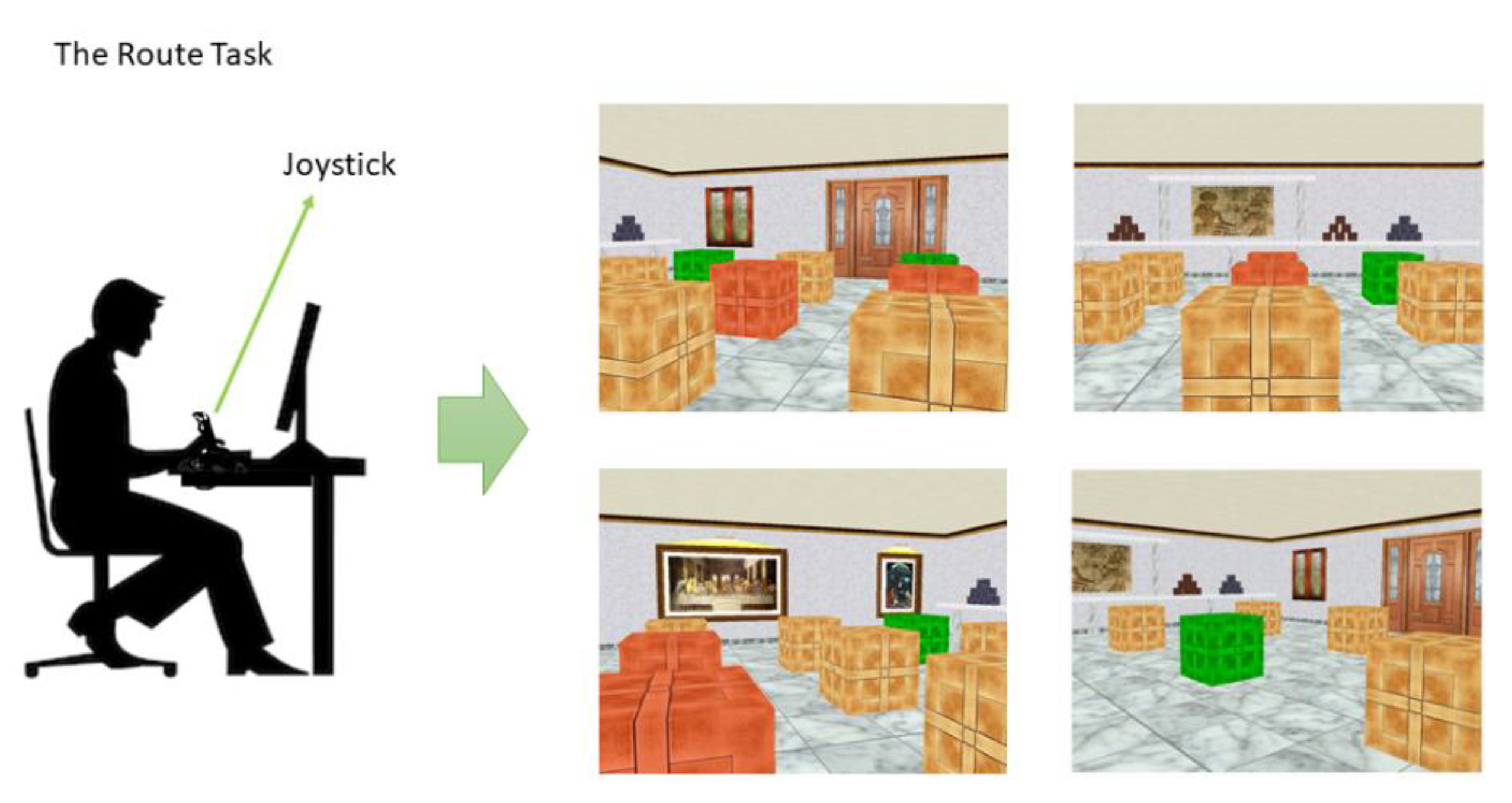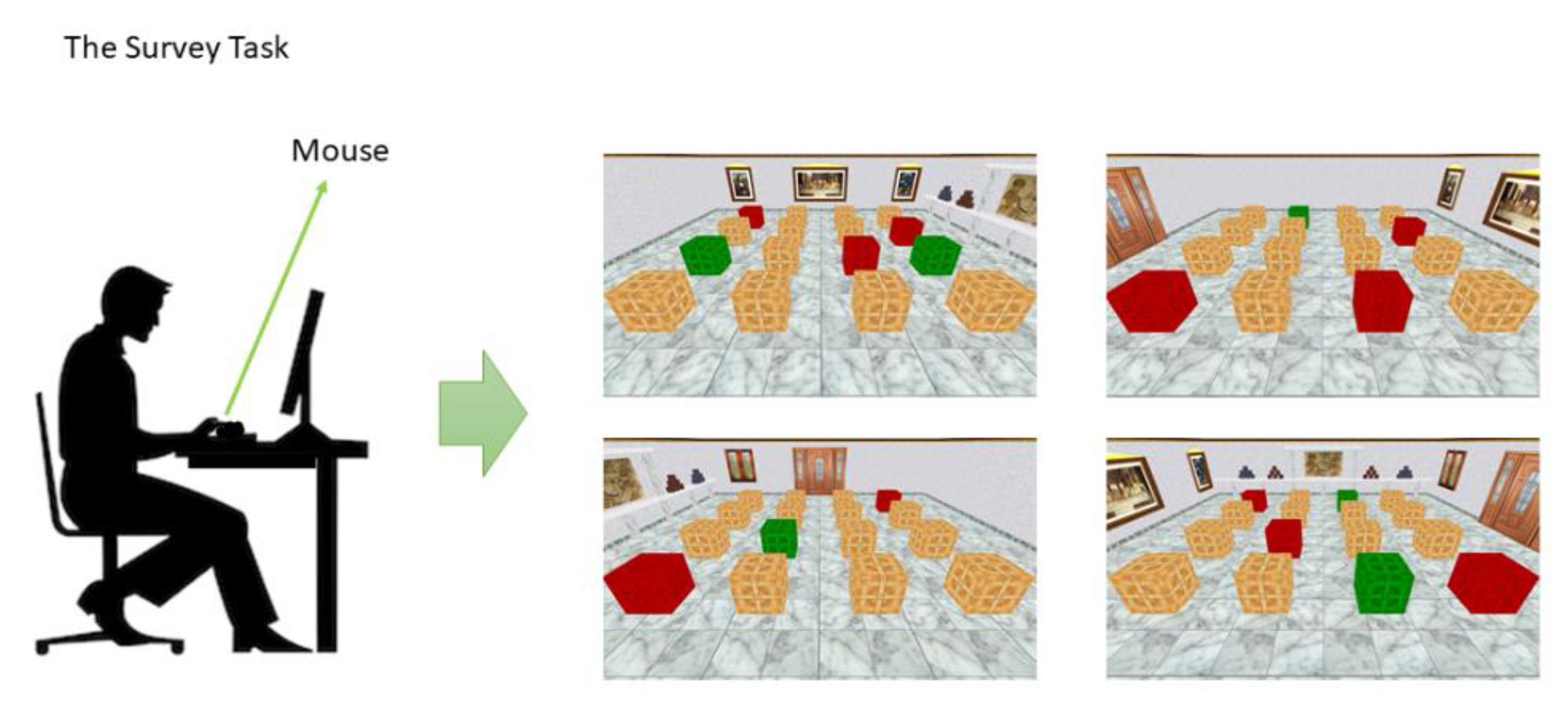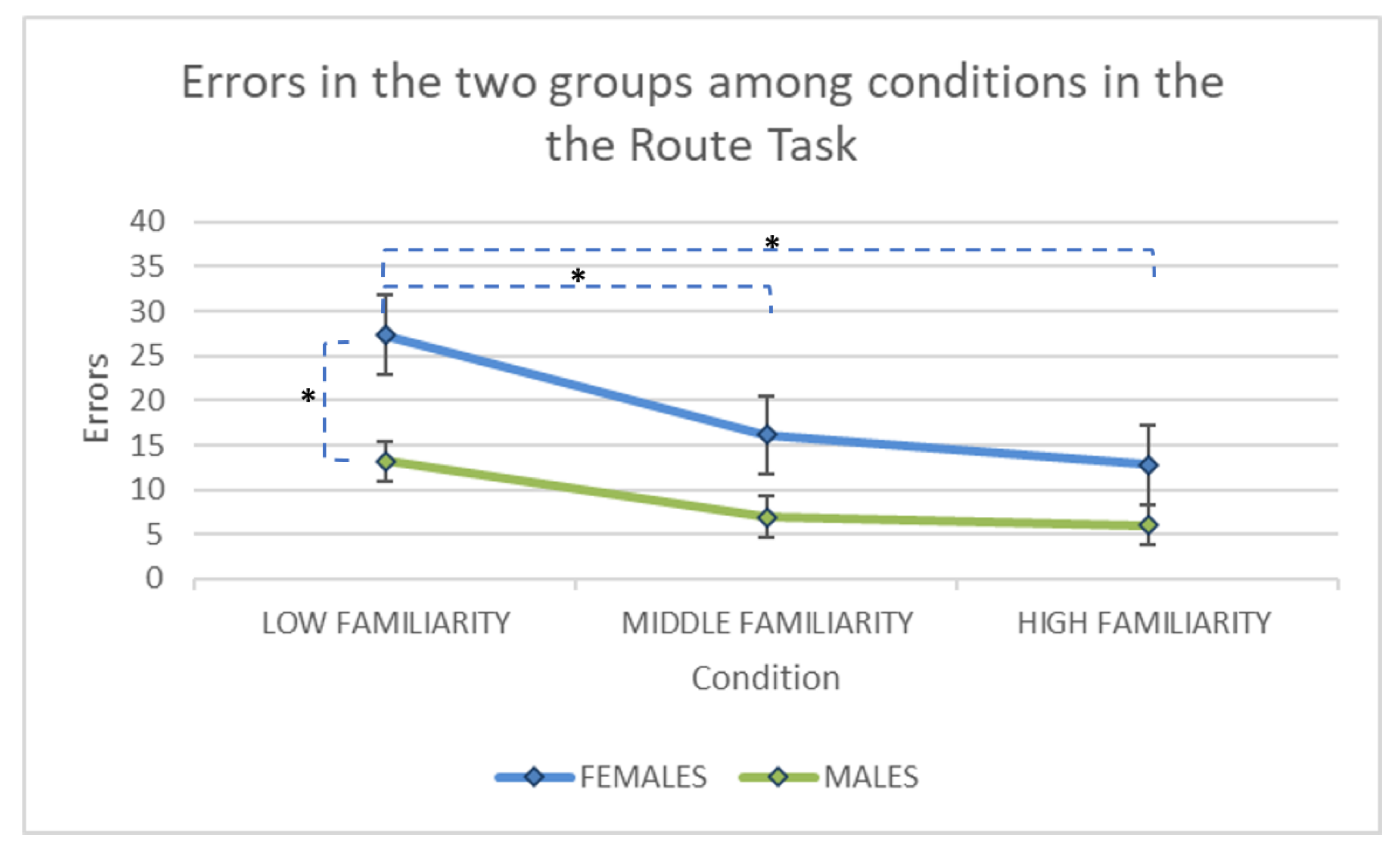The Role of Gender and Familiarity in a Modified Version of the Almeria Boxes Room Spatial Task
Abstract
1. Introduction
2. Materials and Methods
2.1. Participants
- Route task: one hundred and four college students (mean age 23.5 ± 16.02; 55 males and 49 females). Age was comparable between groups (t(102) = −0.391; p = 0.146).
- Survey task: one hundred and nine college students (mean age 21.85 ± 2.60; 52 males and 57 females). Age was comparable between groups (t(107) = 1.787; p = 0.077).
2.2. Procedure
2.2.1. The Route Task
2.2.2. The Survey Task
3. Analyses
4. Results
4.1. Effect of Nationality
4.2. Gender Differences: Route Task
4.3. Gender Difference: Survey Task
5. Discussion
6. Conclusions
Author Contributions
Funding
Institutional Review Board Statement
Informed Consent Statement
Data Availability Statement
Conflicts of Interest
References
- Galati, G.; Lobel, E.; Berthoz, A.; Pizzamiglio, L.; Le Bihan, D.; Vallar, G. The neural basis of egocentric and allocentric coding of space in humans: A functional magnetic resonance study. Exp. Brain Res. 2000, 133, 156–164. [Google Scholar] [CrossRef]
- Ruotolo, F.; van der Ham, I.J.; Iachini, T.; Postma, A. The relationship between allocentric and egocentric frames of reference and categorical and coordinate spatial information processing. Q. J. Exp. Psychol. 2011, 64, 1138–1156. [Google Scholar] [CrossRef] [PubMed]
- Siegel, A.W.; White, S.H. The development of spatial representations of large-scale environments. In Advances in Child Development and Behavior; Hayne, W.R., Ed.; Elsevier: Amsterdam, The Netherlands, 1975; pp. 9–55. [Google Scholar]
- Tversky, B. Distortions in Memory for Visual Displays. Spatial Instruments and Spatial Displays; Taylor and Francis: Abingdon-on-Thames, UK, 1991; pp. 61–75. [Google Scholar]
- Montello, D.R. A new framework for understanding the acquisition of spatial knowledge in large-scale environments. In Spatial and Temporal Reasoning in Geographic Information Systems; Egenhofer, M.J., Golledge, R.G., Eds.; Oxford University Press: New York, NY, USA, 1998; pp. 143–154. [Google Scholar]
- Montello, D.R. Navigation; Cambridge University Press: Cambridge, UK, 1998. [Google Scholar]
- Nori, R.; Piccardi, L.; Maialetti, A.; Goro, M.; Rossetti, A.; Argento, O.; Guariglia, C. No gender differences in egocentric and allocentric environmental transformation after compensating for male advantage by manipulating familiarity. Front. Neurosci. 2018, 12, 204. [Google Scholar] [CrossRef]
- Cimadevilla, J.M.; Piccardi, L. Spatial skills. Handb. Clin. Neurol. 2020, 175, 65–79. [Google Scholar] [CrossRef] [PubMed]
- Palmiero, M.; Piccardi, L. The role of emotional landmarks on topographical memory. Front. Psychol. 2017, 8, 763. [Google Scholar] [CrossRef] [PubMed]
- Piccardi, L.; Guariglia, C.; Nori, R.; Palmiero, M. The role of emotional landmarks in embodied and not-embodied tasks. Brain Sci. 2020, 10, 58. [Google Scholar] [CrossRef]
- Nico, D.; Piccardi, L.; Iaria, G.; Bianchini, F.; Zompanti, L.; Guariglia, C. Landmark based navigation in brain-damaged patients with neglect. Neuropsychologia 2008, 46, 1898–1907. [Google Scholar] [CrossRef]
- Kitchin, R.M. Cognitive maps: What are they and why study them? J. Environ. Psychol. 1994, 14, 1–19. [Google Scholar] [CrossRef]
- Piccardi, L.; Palmiero, M.; Bocchi, A.; Giannini, A.M.; Boccia, M.; Baralla, F.; Cordellieri, P.; D’Amico, S. Continuous environmental changes may enhance topographic memory skills. evidence from L’Aquila earthquake-exposed survivors. Front. Human Neurosci. 2018, 12, 318. [Google Scholar] [CrossRef]
- Gärling, T.; Böök, A.; Lindberg, E. Spatial orientation and wayfinding in the designed environment: A conceptual analysis and some suggestions for post occupancy evaluation. J. Arch. Plan. Res. 1986, 3, 55–64. [Google Scholar]
- Nori, R.; Piccardi, L. Familiarity and spatial cognitive style: How important are they for spatial representation? In Spatial Memory: Visuospatial Processes, Cognitive Performance and Developmental Effects; Jacob, B.T., Ed.; Nova Science Publishers, Inc.: Hauppauge, NY, USA, 2011; pp. 123–144. [Google Scholar]
- Piccardi, L.; Risetti, M.; Nori, R. Familiarity and environmental representations of a city: A self-report study. Psychol. Rep. 2011, 109, 309–326. [Google Scholar] [CrossRef]
- Piccardi, L.; Palmiero, M.; Bocchi, A.; Boccia, M.; Guariglia, C. How does environmental knowledge allow us to come back home? Exp. Brain Res. 2019, 237, 1811–1820. [Google Scholar] [CrossRef]
- Verde, P.; Piccardi, L.; Bianchini, F.; Guariglia, C.; Carrozzo, P.; Morgagni, F.; Tomao, E. Gender differences in navigational memory: Pilots vs. nonpilots. Aerosp. Med. Hum. Perform. 2015, 86, 103–111. [Google Scholar] [CrossRef]
- Nori, R.; Palmiero, M.; Bocchi, A.; Giannini, A.M.; Piccardi, L. The specific role of spatial orientation skills in predicting driving behaviour. Transp. Res. Part F Traffic Psychol. Behav. 2020, 71, 259–271. [Google Scholar] [CrossRef]
- Bocchi, A.; Palmiero, M.; Nori, R.; Verde, P.; Piccardi, L. Does spatial cognitive style affect how navigational strategy is planned? Exp. Brain Res. 2019, 237, 2523–2533. [Google Scholar] [CrossRef] [PubMed]
- Bocchi, A.; Giancola, M.; Piccardi, L.; Palmiero, M.; Nori, R.; D’Amico, S. How would you describe a familiar route or put in order the landmarks along it? It depends on your cognitive style! Exp. Brain Res. 2018, 236, 3121–3129. [Google Scholar] [CrossRef] [PubMed]
- Boccia, M.; Piccardi, L.; Di Marco, M.; Pizzamiglio, L.; Guariglia, C. Does field independence predict visuo-spatial abilities underpinning human navigation? Behavioural evidence. Exp. Brain Res. 2016, 234, 2799–2807. [Google Scholar] [CrossRef] [PubMed]
- Boccia, M.; Piccardi, L.; D’Alessandro, A.; Nori, R.; Guariglia, C. Restructuring the navigational field: Individual predisposition towards field independence predicts preferred navigational strategy. Exp. Brain Res. 2017, 235, 1741–1748. [Google Scholar] [CrossRef]
- Lancia, S.; Cofini, V.; Carrieri, M.; Ferrari, M.; Quaresima, V. Are ventrolateral and dorsolateral prefrontal cortices involved in the computerized Corsi block-tapping test execution? An fNIRS study. Neurophotonics 2018, 5, 011019. [Google Scholar] [CrossRef]
- Nori, R.; Piccardi, L.; Migliori, M.; Guidazzoli, A.; Frasca, F.; De Luca, D.; Giusberti, F. The virtual reality Walking Corsi Test. Comput. Hum. Behav. 2015, 48, 72–77. [Google Scholar] [CrossRef]
- Coluccia, E.; Louse, G. Gender differences in spatial orientation: A review. J. Environ. Psychol. 2004, 24, 329–340. [Google Scholar] [CrossRef]
- Voyer, D.; Voyer, S.D.; Saint-Aubin, J. Sex differences in visual-spatial working memory: A meta-analysis. Psychon. Bull. Rev. 2017, 24, 307–334. [Google Scholar] [CrossRef] [PubMed]
- Voyer, D.; Postma, A.; Brake, B.; Imperato-McGinley, J. Gender differences in object location memory: A meta-analysis. Psychon. Bull. Rev. 2007, 14, 23–38. [Google Scholar] [CrossRef]
- Piccardi, L.; D’Antuono, G.; Marin, D.; Boccia, M.; Ciurli, P.; Incoccia, C.; Antonucci, G.; Verde, P.; Guariglia, C. New evidence for gender differences in performing the Corsi Test but not the Digit Span: Data from 208 individuals. Psychol. Stud. 2019, 64, 411–419. [Google Scholar] [CrossRef]
- Palmiero, M.; Nori, R.; Rogolino, C.; D’Amico, S.; Piccardi, L. Situated navigational working memory: The role of positive mood. Cognit. Process. 2015, 16, 327–330. [Google Scholar] [CrossRef]
- Boone, A.P.; Maghen, B.; Hegarty, M. Instructions matter: Individual differences in navigation strategy and ability. Mem. Cogn. 2019, 47, 1401–1414. [Google Scholar] [CrossRef] [PubMed]
- Lawton, C.A. Gender differences in way-findings strategies: Relationship to spatial ability and spatial anxiety. Sex Roles 1994, 30, 765–779. [Google Scholar] [CrossRef]
- Galea, L.A.M.; Kimura, D. Sex differences in route learning. Pers. Individ. Dif. 1993, 14, 53–65. [Google Scholar] [CrossRef]
- Lawton, C.A. Strategies for indoor wayfinding: The role of orientation. J. Environ. Psychol. 1996, 16, 137–145. [Google Scholar] [CrossRef]
- Lawton, C.A.; Charleston, S.I.; Zieles, A.S. Individual and gender related differences in indoor wayfindings. Environ. Behav. 1996, 28, 204–219. [Google Scholar] [CrossRef]
- O’Laughlin, E.M.; Brubaker, B.S. Use of landmarks in cognitive mapping: Gender differences in self report versus performance. Pers. Individ. Dif. 1998, 24, 595–601. [Google Scholar] [CrossRef]
- Bocchi, A.; Palmiero, M.; Piccardi, L. Travel planning in men and women. Who is better? Curr. Psychol. 2021, 1–8. [Google Scholar] [CrossRef]
- Munion, A.K.; Stefanucci, J.K.; Rovira, E.; Squire, P.; Hendricks, M. Gender differences in spatial navigation: Characterizing wayfinding behaviors. Psychon. Bull. Rev. 2019, 26, 1933–1940. [Google Scholar] [CrossRef] [PubMed]
- Boone, A.P.; Gong, X.; Hegarty, M. Sex differences in navigation strategy and efficiency. Mem. Cogn. 2018, 46, 909–922. [Google Scholar] [CrossRef]
- Grön, G.; Wunderlich, A.P.; Spitzer, M.; Tomczak, R.; Riepe, M.W. Brain activation during human navigation: Gender-different neural networks as substrate of performance. Nat. Neurosci. 2000, 3, 404–408. [Google Scholar] [CrossRef] [PubMed]
- Bell, P.A.; Greene, T.C.; Fisher, J.D.; Baum, A. Environmental Psychology, 5th ed.; Harcourt College Publishers: New York, NY, USA, 2001. [Google Scholar]
- Evans, G.W.; Marrero, D.G.; Butler, P.A. Environmental learning and cognitive mapping. Environ. Behav. 1981, 13, 83–104. [Google Scholar] [CrossRef]
- Thorndyke, P.W.; Hayes-Roth, B. Differences in spatial knowledge acquired from mapsand navigation. Cogn. Psychol. 1982, 14, 560–589. [Google Scholar] [CrossRef]
- Iachini, T.; Ruotolo, F.; Ruggiero, G. The effects of familiarity and gender on spatial representation. J. Environ. Psychol. 2009, 29, 227–234. [Google Scholar] [CrossRef]
- Iaria, G.; Bogod, N.; Fox, C.J.; Barton, J.J. Developmental topographical disorientation: Case one. Neuropsychologia 2009, 47, 30–40. [Google Scholar] [CrossRef]
- De Goede, M.; Postma, A. Learning your way in a city: Experience and gender differences in configurational knowledge of one’s environment. Front. Pscyhol. 2015, 6, 402. [Google Scholar] [CrossRef]
- Nori, R.; Piccardi, L. Il senso dell’orientamento: Quanto conta la familiarità con l’ambiente? Giorn. It. Psicol. 2012, 39, 43–368. [Google Scholar]
- Lopez, A.; Caffò, A.O.; Bosco, A. Topographical disorientation in aging. Familiarity with the environment does matter. Neurol. Sci. 2018, 39, 1519–1528. [Google Scholar] [CrossRef]
- Montello, D.R.; Lovelace, K.L.; Golledge, R.G.; Self, C.M. Sex-related differences and similarities in geographic and environmental spatial abilities. Ann. Am. Assoc. Geogr. 1999, 89, 515–534. [Google Scholar] [CrossRef]
- Cánovas, R.; Espínola, M.; Iribarne, L.; Cimadevilla, J.M. A new virtual task to evaluate human place learning. Behav. Brain Res. 2008, 190, 112–118. [Google Scholar] [CrossRef] [PubMed]
- Tascón, L.; Castillo, J.; León, I.; Cimadevilla, J.M. Walking and non-walking space in an equivalent virtual reality task: Sexual dimorphism and aging decline of spatial abilities. Behav. Brain Res. 2018, 347, 201–208. [Google Scholar] [CrossRef]
- Keefe, J.; Nadel, L. The Hippocampus as a Cognitive Map; Oxford University Press: Oxford, UK, 1978. [Google Scholar]
- León, I.; Tascón, L.; Ortells-Pareja, J.J.; Cimadevilla, J.M. Virtual reality assessment of walking and non-walking space in men and women with virtual reality-based tasks. PLoS ONE 2018, 13, e0204995. [Google Scholar] [CrossRef]
- Lawton, C.A. Gender, spatial abilities, and wayfinding. In Handbook of Gender Research in Psychology; Springer: New York, NY, USA, 2010; pp. 317–341. [Google Scholar]
- Nazareth, A.; Huang, X.; Voyer, D.; Newcombe, N. A meta-analysis of sex differences in human navigation skills. Psychon. Bull. Rev. 2019, 26, 1503–1528. [Google Scholar] [CrossRef] [PubMed]
- Bianchini, F.; Incoccia, C.; Palermo, L.; Piccardi, L.; Zompanti, L.; Sabatini, U.; Guariglia, C. Developmental topographical disorientation in a healthy subject. Neuropsychologia 2010, 48, 1563–1573. [Google Scholar] [CrossRef]
- Astur, R.S.; Ortiz, M.L.; Sutherland, R.J. A characterization of performance by men and women in a virtual Morris water task: A large and reliable sex difference. Behav Brain Res. 1998, 93, 185–190. [Google Scholar] [CrossRef]
- Tan, D.S.; Czerwinski, M.P.; Robertson, G.G. Large displays enhance optical flow cues and narrow the gender gap in 3-D virtual navigation. Human Fact. 2006, 48, 318–333. [Google Scholar]
- Piccardi, L.; Iaria, G.; Ricci, M.; Bianchini, F.; Zompanti, L.; Guariglia, C. Walking in the Corsi test: Which type of memory do you need? Neurosci. Lett. 2008, 432, 127–131. [Google Scholar] [CrossRef] [PubMed]
- Piccardi, L.; Bianchini, F.; Argento, O.; De Nigris, A.; Maialetti, A.; Palermo, L.; Guariglia, C. The walking corsi test (WalCT): Standardization of the topographical memory test in an Italian population. Neurol. Sci. 2013, 34, 971–978. [Google Scholar] [CrossRef]
- Piccardi, L.; Bianchini, F.; Nori, R.; Marano, A.; Iachini, F.; Lasala, L.; Guariglia, C. Spatial location and pathway memory compared in the reaching versus walking domains. Neurosci. Lett. 2014, 566, 226–230. [Google Scholar] [CrossRef] [PubMed]
- Nori, R.; Piccardi, L.; Pelosi, A.; De Luca, D.; Frasca, F.; Giusberti, F. Perspective changing in WalCT and VR-WalCT: A gender difference study [WalCT–VR-WalCT: Gender differences]. Comput. Hum. Behav. 2015, 53, 316–323. [Google Scholar] [CrossRef]
- Piccardi, L.; Bianchini, F.; Iasevoli, L.; Giannone, G.; Guariglia, C. Sex differences in a landmark environmental re-orientation task only during the learning phase. Neurosci. Lett. 2011, 503, 181–185. [Google Scholar] [CrossRef]
- Nori, R.; Piccardi, L. I believe I’m good at orienting myself. But is that true? Cogn. Proc. 2015, 16, 301–307. [Google Scholar]




| Males | Females | Italy | Spain | |
|---|---|---|---|---|
| Route task N = 104 | 55 | 49 | 55 | 49 |
| Survey task N = 109 | 52 | 57 | 63 | 46 |
Publisher’s Note: MDPI stays neutral with regard to jurisdictional claims in published maps and institutional affiliations. |
© 2021 by the authors. Licensee MDPI, Basel, Switzerland. This article is an open access article distributed under the terms and conditions of the Creative Commons Attribution (CC BY) license (https://creativecommons.org/licenses/by/4.0/).
Share and Cite
Bocchi, A.; Palmiero, M.; Redondo, J.M.C.; Tascón, L.; Nori, R.; Piccardi, L. The Role of Gender and Familiarity in a Modified Version of the Almeria Boxes Room Spatial Task. Brain Sci. 2021, 11, 681. https://doi.org/10.3390/brainsci11060681
Bocchi A, Palmiero M, Redondo JMC, Tascón L, Nori R, Piccardi L. The Role of Gender and Familiarity in a Modified Version of the Almeria Boxes Room Spatial Task. Brain Sciences. 2021; 11(6):681. https://doi.org/10.3390/brainsci11060681
Chicago/Turabian StyleBocchi, Alessia, Massimiliano Palmiero, Jose Manuel Cimadevilla Redondo, Laura Tascón, Raffaella Nori, and Laura Piccardi. 2021. "The Role of Gender and Familiarity in a Modified Version of the Almeria Boxes Room Spatial Task" Brain Sciences 11, no. 6: 681. https://doi.org/10.3390/brainsci11060681
APA StyleBocchi, A., Palmiero, M., Redondo, J. M. C., Tascón, L., Nori, R., & Piccardi, L. (2021). The Role of Gender and Familiarity in a Modified Version of the Almeria Boxes Room Spatial Task. Brain Sciences, 11(6), 681. https://doi.org/10.3390/brainsci11060681










